Bath siphons: varieties and their characteristics
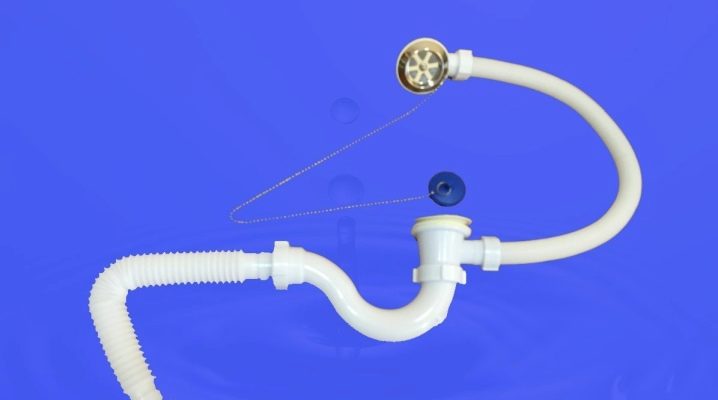
To connect the plumbing to the sewer system, special parts are used - siphons. Thanks to these components, water drains are sent to the riser, and any unpleasant odors remain in the pipes. Many consumers are unaware of the fact that siphons are different and have different characteristics. Let's consider these important details in more detail and get acquainted with their properties.
What it is?
Before proceeding to a detailed acquaintance with siphons, you should answer the question of what they are.
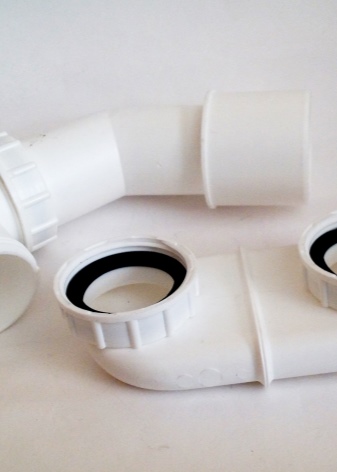

The siphon is a special curved pipe. This detail plays one of the most important roles in the drainage system. Siphons are always installed in dwellings where there is a sewage system. These elements let the water pass through them, which has previously passed through the filter and mixer.
Peculiarities
Having modern plumbing items, you simply cannot do without a high-quality siphon.
As a rule, this part is assembled from 2 main elements:
- from a drain pipe, which is intended for draining water;
- overflow barrel, which is necessary to protect against overflow through the sides of the bath.
A well-chosen and high-quality siphon ensures correct water circulation. In addition, this component blocks unpleasant odors coming from the sewer.
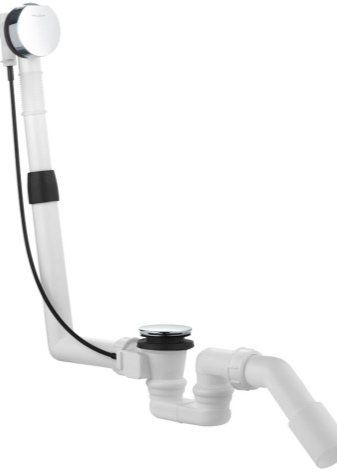
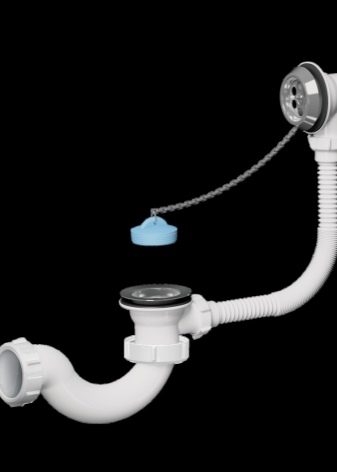
The bath siphon contains the main parts, which include:
- neck;
- nozzle (can be soft or hard);
- overflow corrugated hose.
In this case, the neck is attached to the bottom of the bath with a metal screw, which holds this part on both sides. At the same time, the screw tightens the inner and outer parts. When installing these components, it is necessary to take care of maximum tightness. A high-quality rubber seal is ideal for this.
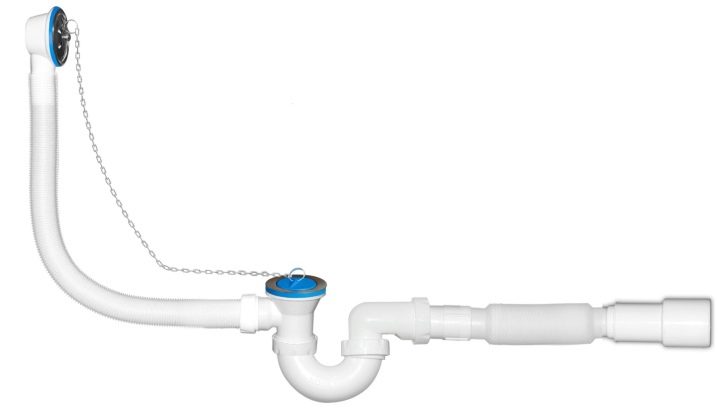
The siphon branch pipe in most cases has a curved structure. Thanks to this form, a certain amount of water always remains in it. It is the water barrier in this case that is responsible for stopping the movement of unpleasant odors.
A corrugated hose is used to drain excess water. In addition, this part is designed to protect against overflowing water over the edges of the plumbing.
The siphon is connected directly to the bathtub not only with soft, but also rigid corrugated pipes. As a rule, the length of these elements can be adjusted in height.
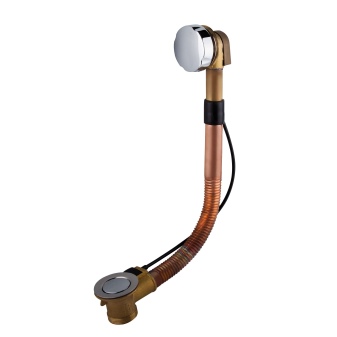
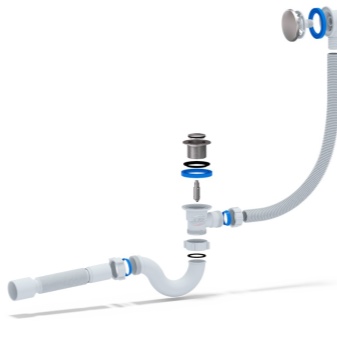
A part such as a siphon is made from various materials. The most popular today are plastic and metal options. Of course, plastic parts are cheaper and more common, but stainless steel siphons last longer and are less susceptible to mechanical damage.
Today in plumbing stores you can find not only standard manual, but also automatic and semi-automatic siphons. According to consumers, it is more convenient to use such products. The main thing is to choose the right model with a reliable and durable automatic movement.
Modern siphons are rich in choice. The assortment of these parts allows you to choose the perfect and durable piece that will serve without causing any problems.
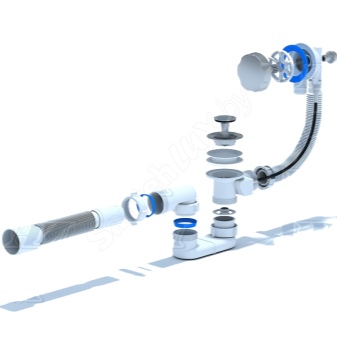
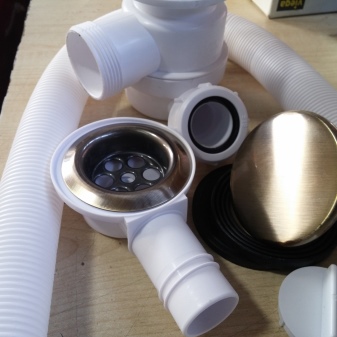
Views
Siphons are different. Each variety of this part has its own distinctive qualities, pros and cons. Let's consider them in more detail.
Tubular
The design of the tubular siphon is based on a simple shape of the pipe bend, which outwardly is very similar to the letter S in a horizontal position.The first bend, which is closer to the drain and ends with a segment directed upwards, acts as a buffer zone between the sewer and the bathroom. A certain amount of water always remains in this part. Other streams, overflowing along the high section, go straight to the sewer.
In this case, a sufficient drainage tightness is ensured by the plug (it must be lifted to open the drain hole). Most often, this part is made of plastic. Dense rubber plugs are no less reliable and durable.
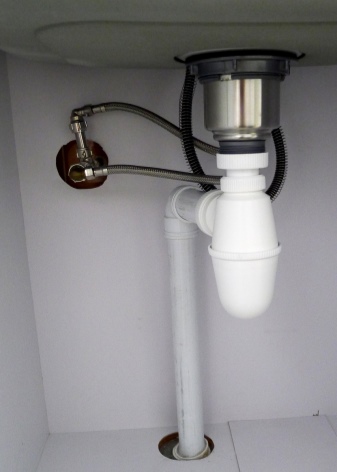
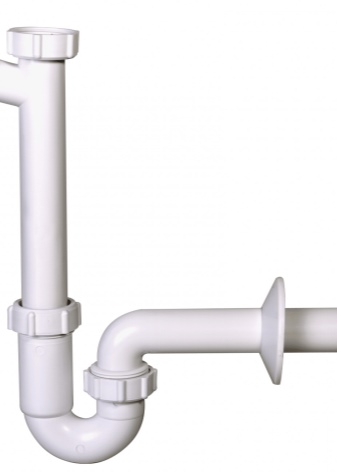
The tubular siphon is small and vertical. Due to these features, such a part is most often mounted in rooms with very limited space under the plumbing.
If you are looking for the most compact and flexible specimen that is easy to install, then you should get a flexible siphon. Its position can be easily adjusted as needed.
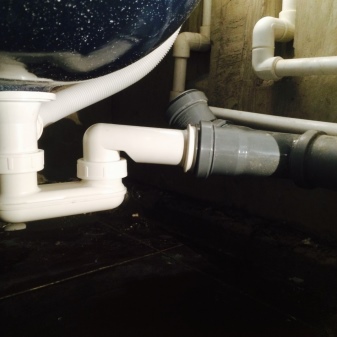
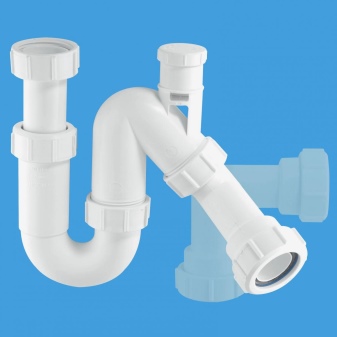
The main advantages of a tubular siphon are:
- simple and straightforward design diagram;
- low cost;
- sufficiently fast drainage, even if contaminated water has sediment particles due to a large section;
- minimal likelihood of penetration of serious blockages;
- simple and quick installation;
- ease of use.
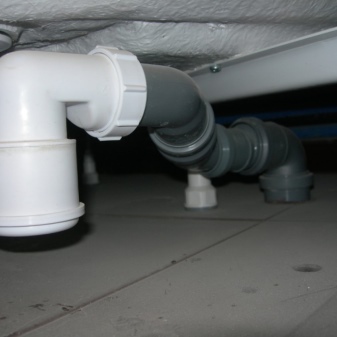
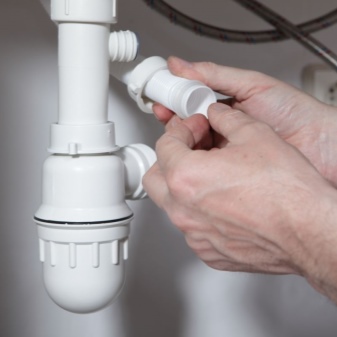
The tubular system has no serious disadvantages. However, some people do not really like the need for constant monitoring of the removable plug. In order not to encounter this unpleasant feature, you need to fix the plug on a flexible chain - this will protect this part from falling to the floor.
To use such a product more conveniently, it is recommended to select a siphon with a flat and collapsible bottom. Such a detail will be very useful if you have to clean the device.
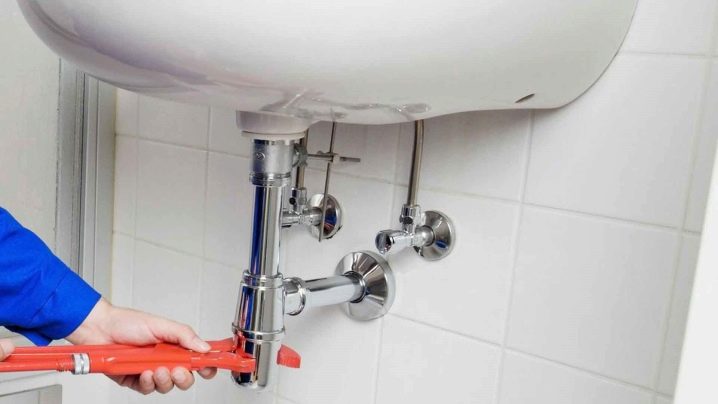
Bottle
A bottle siphon is a type of siphon that is made in the shape of a bottle. The outlet pipe in it is located on the side.
The bottle siphon is mounted on a pipe that extends directly from the drain. The branch pipe in this case is at a height that corresponds to the bottom of the siphon. This parameter is responsible for the volume of water that always remains in the water seal.


The main advantages of such devices are:
- small horizontal dimensions;
- attractive appearance;
- easy and quick cleaning if necessary.
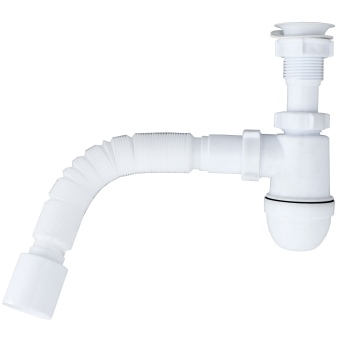
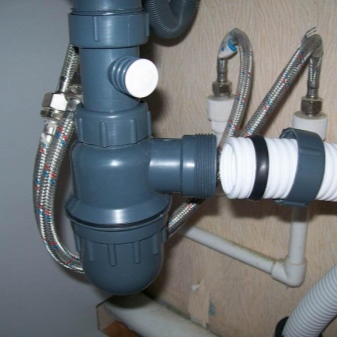
With the help of a collapsible design, you can quickly and easily clean such a siphon, without spending a lot of time and effort. More modern types of bottle devices are equipped with an additional branch pipe on top, supplemented with a special plug. You can connect a washing machine to such a device without any problems.
The main disadvantage of the bottle version is the high susceptibility to blockages. Most often they form around large particles trapped in the interior of the debris.

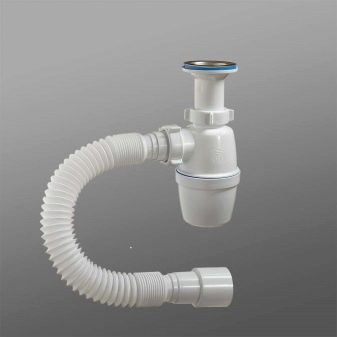
Ladder
The ladder is a flat type of siphon. Such a detail is characterized by a small height without overflow. Most often, such devices are used when arranging a drain in the bathroom floor.

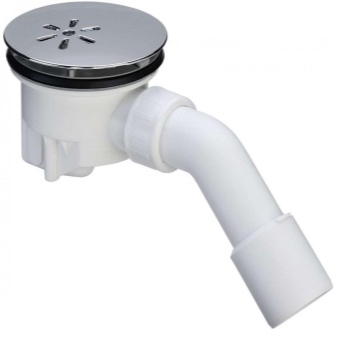
The flat siphon is the ideal solution if you are buying a piece for a small space. In it, the shutter element is located in the horizontal plane. To clean such a device, you only need to partially disassemble the existing system.
Modern types of siphon differ not only in their structure and installation method, but also in the operation of the entire system.
Classical
Classic siphons are perfect for bathtubs with overflow. Such devices may contain plugs made of different materials. For example, plastic, rubber and even metal. These parts for the drain hole are removed by hand. To make the use of classic devices more convenient, the plugs are usually equipped with a strong chain, by which they can be easily "picked up" and taken out of the hole.
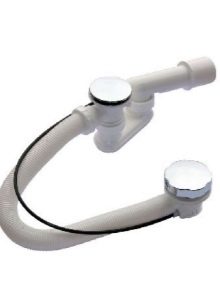
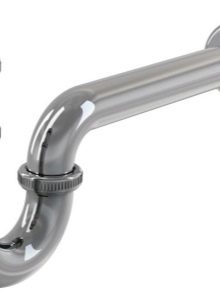

Standard mechanical devices consist of the following parts:
- drain neck;
- overflow pipe;
- corrugated pipe;
- siphon;
- spout tubes;
- plug that closes the drain hole.
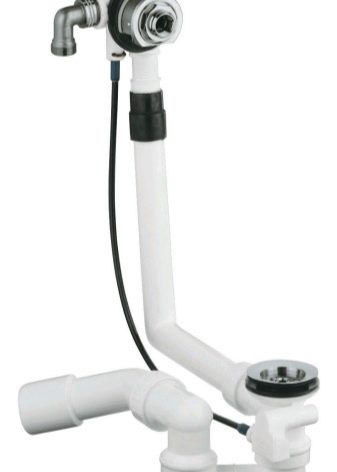
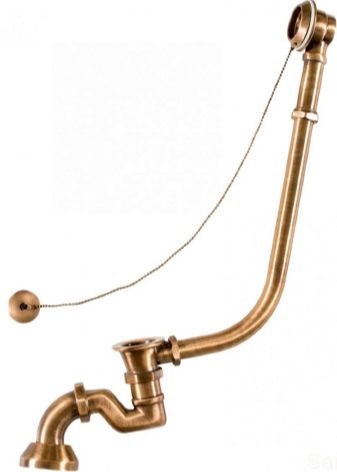
Semi-automatic
Semi-automatic siphons are no less popular and widespread. In them, the mechanisms responsible for the drain and overflow are connected using a small cable. It is the last detail that is responsible for blocking the water in the appropriate place. Most often, in this case, the overflow cover acts as a control lever, which can be turned.
One of the advantages of semi-automatic copies is their attractive appearance. In addition, they are very convenient to use, according to consumers. You can close the drain in these devices with just a couple of movements, without bending down.
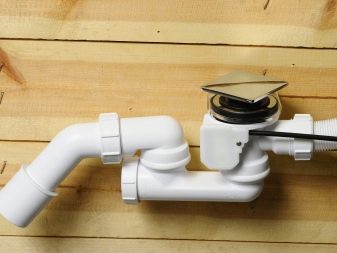
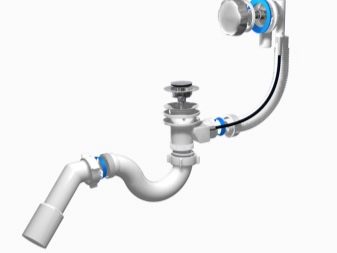
Semi-automatic siphons are made in the form:
- buttons;
- swivel ring;
- handles;
- decorative valve.
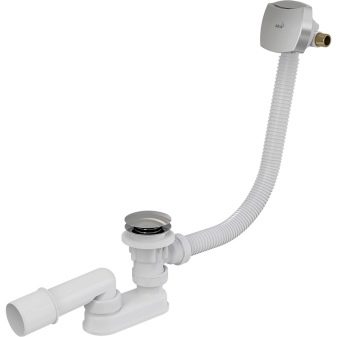
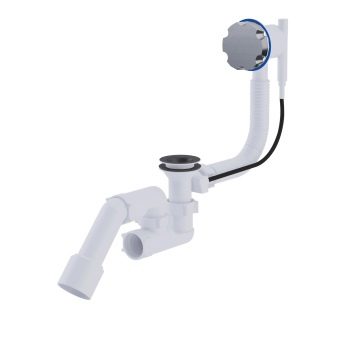
Auto
The most modern and convenient by right is recognized as the automatic strapping option, which regulates the level of water contained in the tank. With such a device for the water outlet, it is enough to press the plug located on two baths. Different people do it differently - some with their hand and some with their feet.
In order not to encounter disturbances in the operation of such devices, it is recommended to contact only experienced specialists. - only professionals can install such a part as reliably as possible.
Before installing the automatic siphon, it should be borne in mind that its presence requires uninterrupted power supply and periodic maintenance.

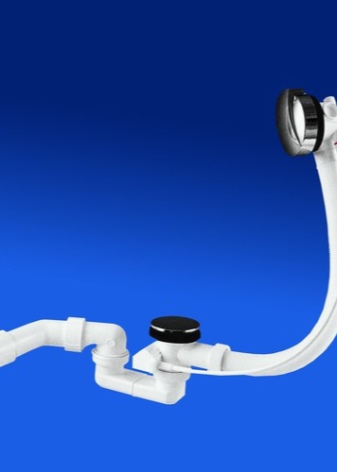
By design, the automatic system is considered the most complex.
The advantages of such siphons are:
- ease of use;
- durability when handled correctly;
- attractive appearance.
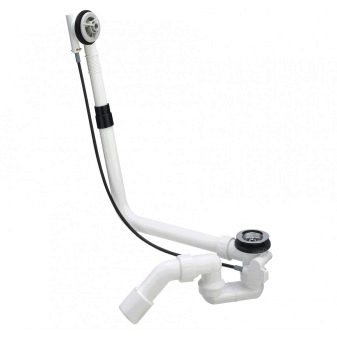
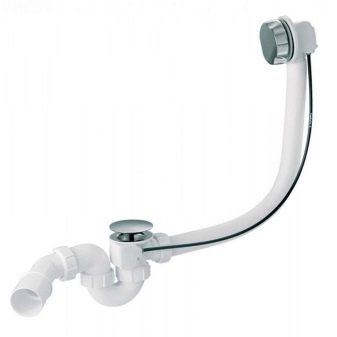
However, such systems also have their drawbacks:
- they are quite expensive;
- most of all others are prone to breakdowns.
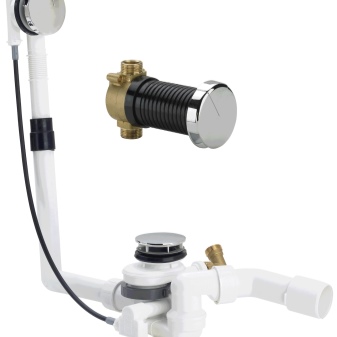
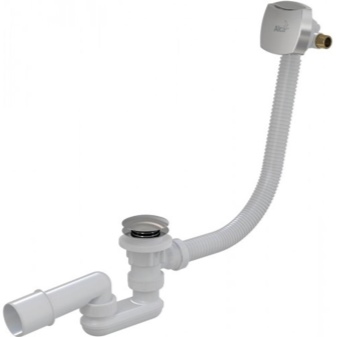
Materials and design
Modern siphon models are made from different materials. Let's take a closer look at the most popular and demanded options.
Cast iron
If you are looking for a truly durable and reliable siphon, then you should pay attention to models from a material such as cast iron. Such raw materials have a long service life and trouble-free operation. These parts are best suited for bathtubs made from similar materials.
Recently, however, cast iron siphons have lost their former popularity. The decrease in demand for such parts is due to the fact that their sizes cannot be adjusted in any way, if necessary. Due to this feature, a cast iron siphon may not fit a bath made of a different material.
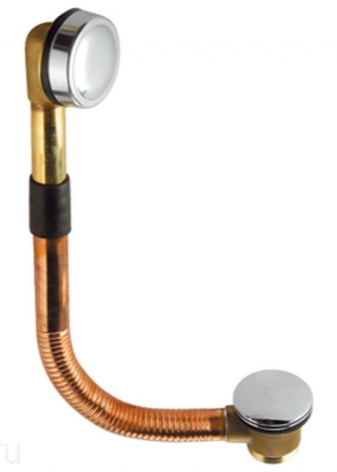

Another serious disadvantage of cast iron siphons is that deforming deposits accumulate on them in a short time. It is not very convenient to clean such devices, since their inner part has slight roughness. It is also worth noting that over the years, cast-iron objects will certainly become covered with rust, getting rid of which can become an almost impossible task.
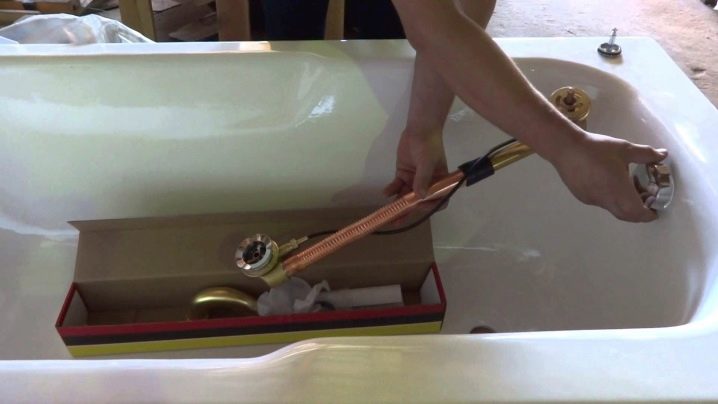
Plastic
One of the most popular today are high-quality siphons made of high-strength plastic.
Such units are in great demand, which is explained by their positive qualities:
- not susceptible to decay and corrosion;
- on the surface of perfectly smooth plastic siphons, grease and dirt do not accumulate;
- such details keep clean both inside and outside;
- due to the flexibility of plastic, siphons made of such material can be adjusted to a variety of types of baths;
- Even harsh chemicals can be used to clean plastic siphons.
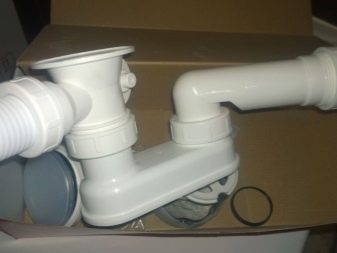
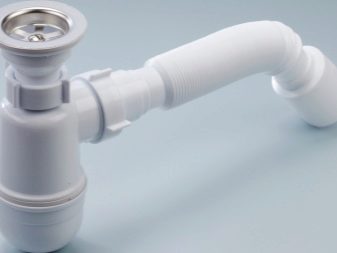
It is worth noting the relatively low cost of plastic aggregates, which makes them even more popular and relevant at the present time.
As for the disadvantages of such parts, they include a significant loss of strength characteristics under the influence of external factors (these include, for example, contact with ultraviolet rays).
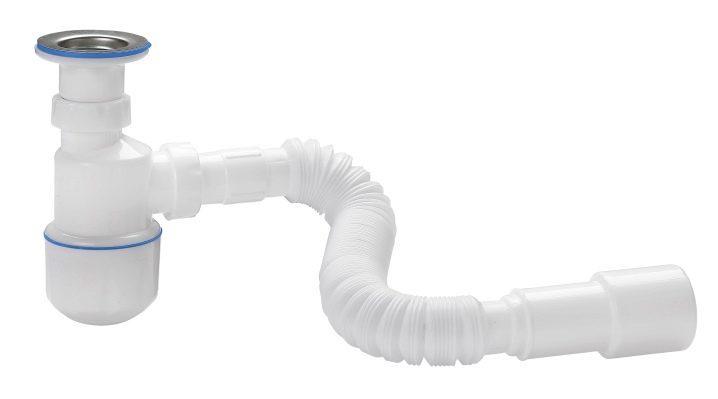
Brass
Brass is an alloy made up of several components, which include:
- copper;
- zinc.
In some cases, brass is supplemented with a small amount of tin, but its content is always much less than the amount of zinc.
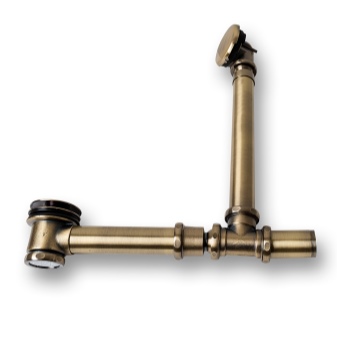
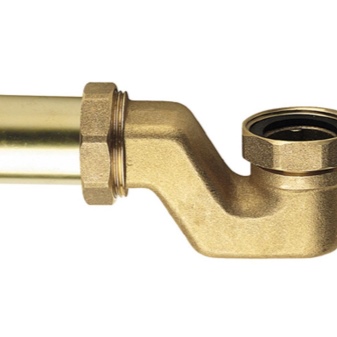
The result is a very durable and reliable material that is not afraid of changes in temperature values, as well as the formation of corrosion.
Brass siphons are distinguished not only by their strength and durability, but also by the unsurpassed protection achieved by chrome plating. Such details have an attractive appearance, so they are often installed in expensive bathroom interiors.
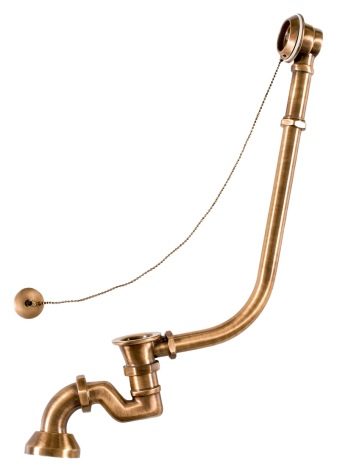
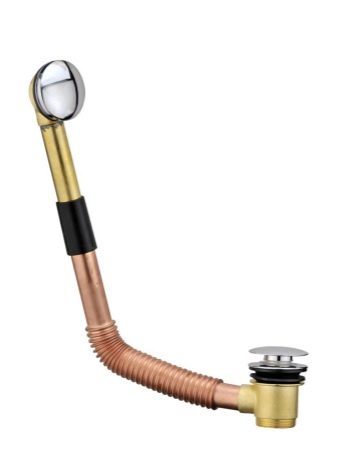
Bronze
Another popular and reliable material for making siphons is bronze. This material is a tough alloy of copper and tin. Its color is close to dark brown.
Bronze siphons are best suited to luxurious interiors, designed in classic and historical stylistic directions. However, it should be noted that these products are not cheap.
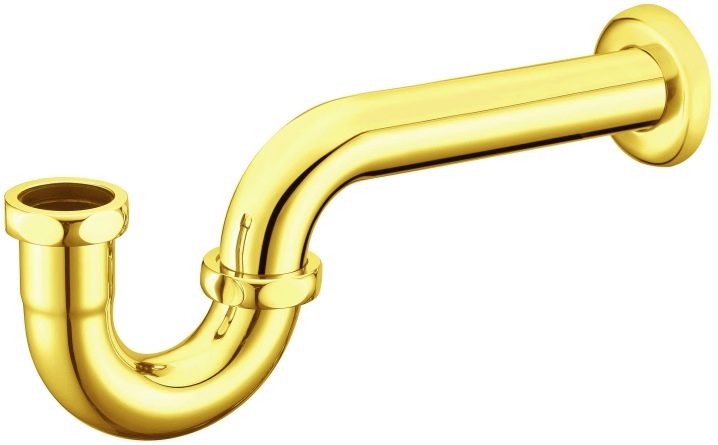
High-quality siphons made of reliable materials can be not only functional, but also aesthetically pleasing. The most attractive are the models with bronze or chrome surfaces. If you do not want to overpay, then you can get by with laconic plastic options that fit seamlessly into almost any bathroom environment.
Criterias of choice
The siphon only seems to be an inconspicuous and insignificant detail. In fact, it plays one of the most important roles in plumbing systems. The selection of such units should be approached seriously and responsibly in order to purchase a high-quality and reliable product that will serve its owners for many years and will not cause any problems.
If you do not want to buy a too expensive model, and its durability and strength are not in the first place, then you can stop at a simple plastic siphon with a manual drain mechanism. This option is quite inexpensive. In addition, plastic siphons are easy to fit in almost any bathtub.
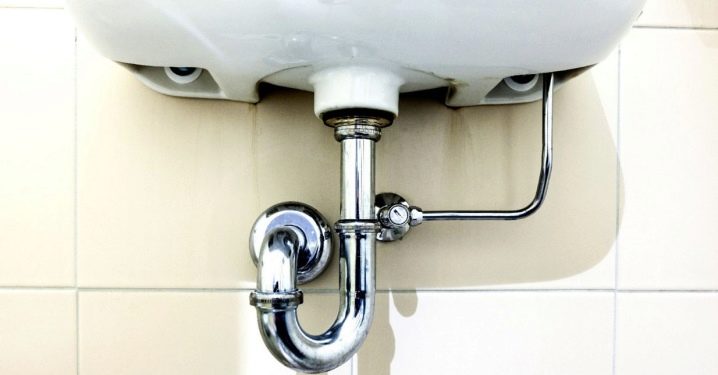
Always pay attention to the manufacturer of the siphon of your choice. You should also be responsible for the choice of material, no matter how expensive it is. For example, if you buy a plastic siphon, then you need to pay attention to its processing and wall thickness. The denser they are, the better. Dense options will last much longer and will not cause any problems during operation. If you buy a brass model, then you need to make sure its smooth surface. Otherwise, the siphon will have to be cleaned frequently.
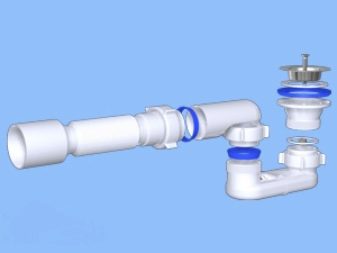

Please note that one siphon can be supplemented with several inlets at once. They can be connected to other devices such as a sink, washing machine or dishwasher. If these nozzles are not used in any way, then they are closed with a special nut. Experts strongly recommend buying just such multifunctional products - in the future they will help you significantly save money on branching the sewer drain.
Suitable rings and gaskets must be selected for each individual siphon model. In order not to face the problem of leaks due to unsuitable locking elements, it is advisable to immediately buy a bath siphon, with which all the rubber bands are included. These accessories are pipe seals and two seals designed specifically for overflows.
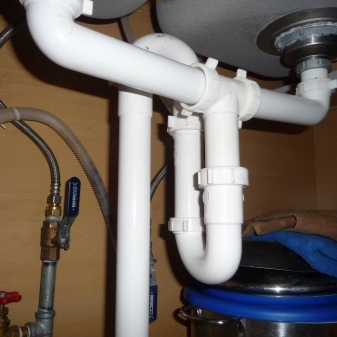
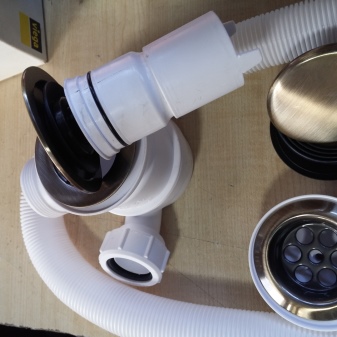
Pay attention to the dimensions of the siphon.Keep in mind that for small spaces under the bathroom, you should select small models, for example, flat ones. They take up a minimum of free space, and caring for them in the future will not pose any problems.
If you are looking for the right model for a pretentious and expensive interior, then you should not give preference to the rustic plastic options. Better buy a more elegant and rich piece of brass, chrome or bronze. Of course, these products are more expensive, but they look more presentable.
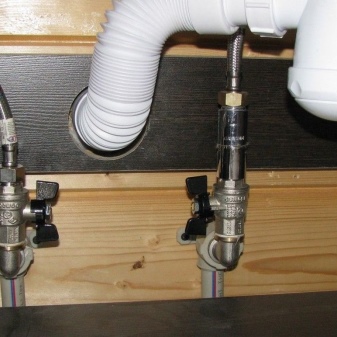
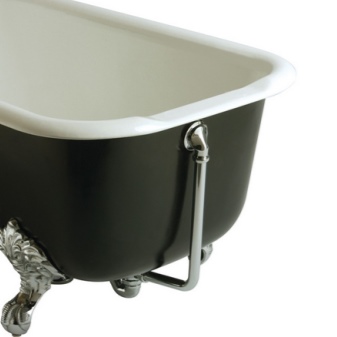
Pay attention to the design of the siphon. For example, in a classic or artsy bathroom interior, a cheap plastic option will not look. For simpler ensembles, you can buy something simpler and more formulaic.
How to assemble?
It is quite possible to assemble a siphon with your own hands. You do not need to have special knowledge and rich experience for this.
First, you should consider what should be included with this device:
- drain pipe for sewerage;
- nut to the nozzle (plastic nuts are considered the best);
- bends designed for drainage and overflow with gaskets and nuts for fasteners;

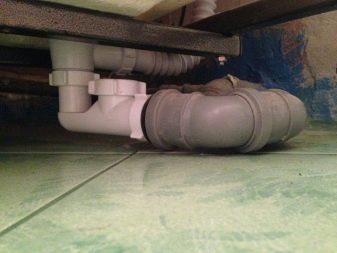
- a jumper made of elastic material (this part will be needed to avoid leaks between the pipe and the drain);
- drain / overflow grates, which are necessary to protect the entire system from the penetration of large particles and objects (gratings can be made of plastic or steel);
- plugs designed specifically for the drain hole.
Be sure to check all components for cracks or other similar damage. It is advisable to do this even in the store in order to save yourself from buying a low-quality kit.

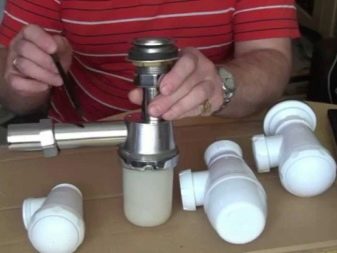
To assemble a siphon yourself, you must:
- First, connect the overflow and sump pipes to each other.
- If you are assembling a plastic product, then you will not need a special FUM-tape, however, in order to connect brass and steel, the thread must be additionally sealed.
- On top and on the side of the siphon there are 2 holes with the same diameter. One of these holes is intended for installing a side drain, and the other is for connecting the structure with a sewer outlet. Depending on the size of the holes, it is necessary to select a special tapered gasket (it must be wide) and a union nut.
- First you need to take a pipe that will need to be connected to the central drain. You will need to put on a union nut, and then a gasket. Take a closer look at its design. One end of the pad is always blunt and the other is sharp.
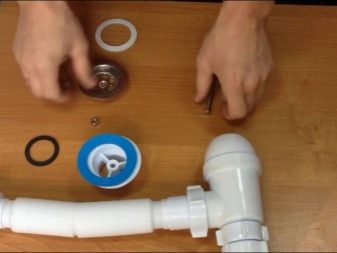
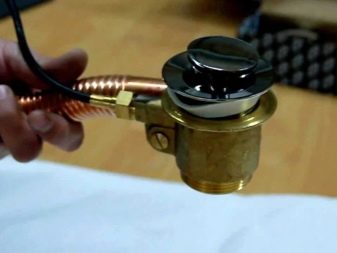
- The pointed end of the seal must be put on the branch pipe. After that, the "blunt" end will find its place on the sump.
- The gasket must be inserted as far as it will go. However, be careful not to damage this part.
- Then the branch pipe should be inserted into a special hole in the device. Then you need to tighten the union nut.
- A similar method is used to connect the branch pipe leading directly to the sewer.
- If all the actions were carried out correctly, then you will still have a wide gasket under the sink and a narrow rubber ring designed to seal the pipe, nuts for connecting the sewer and the sink drain filter.
- A wide gasket must be installed on the upper branch pipe. Then the outlet must be connected to the sink.

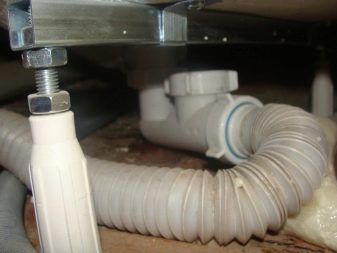
Mounting
When you have assembled the siphon, you can start installing it. This work is also quite accessible and understandable.
Let's consider step by step how to independently install the assembled bath siphon.
- First you need to unscrew the old siphon. Then clean the joints as thoroughly as possible, as well as the insides of the pipe.
- Now you can proceed to the installation of the bottom overflow. A gasket must be put on the end of the lower end of this part.The overflow should now be placed directly on the drain.
- At the same time, a second pad must be attached to the hole. Next, a screw is inserted into it.
- After installing the tapered gasket, you will get a not very tight connection, which will definitely lead to leaks in the future. Only after you are convinced of the correct execution of your actions, you need to hold the pipe with one hand and tighten the screw with a screwdriver with the other.
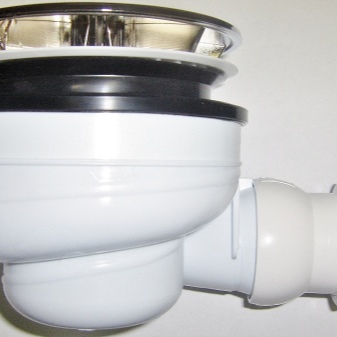
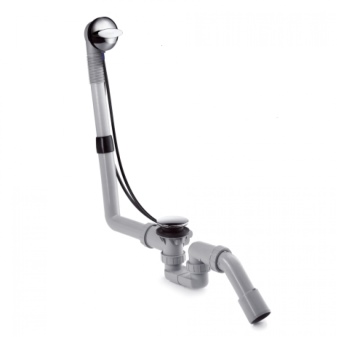
- Now you can start installing the top overflow. It joins in exactly the same way as the bottom one. To make the installation work faster and easier, experts advise to direct the pipe not vertically down, but to move it to the side (closer to yourself).
- Now you need to make the connection of the drain and overflow. In this case, the most convenient is the use of a corrugated hose, which can be easily bent if necessary. Using the nuts to seal the existing connections, gaskets must be placed on them. They should be installed with their thin ends towards the necks.
- Next, you need to move on to installing the water seal. Before connecting the water seal to the neck, you need to carefully consider the places for laying the gaskets. If there are any defects, they must be sanded with a file.
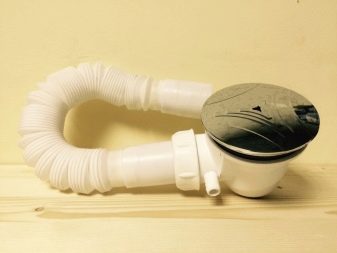
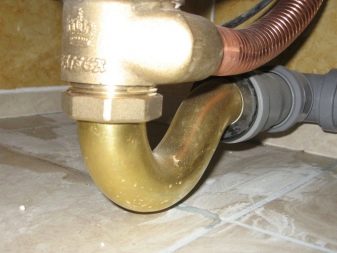
- In any siphon model, the water seal is connected to the throat using a union nut. This part can also be supplemented with a gasket (tapered or flat).
- Now you can proceed to the direct connection of the siphon to the sewer system. Depending on the model of the device, the connection must be made directly into the socket or through the seal collar.
- All connections must be sealed as securely as possible. Since rubber gaskets cannot boast of durability, for greater reliability and strength, it is recommended to seal all joints with a high-quality silicone-based sealant.
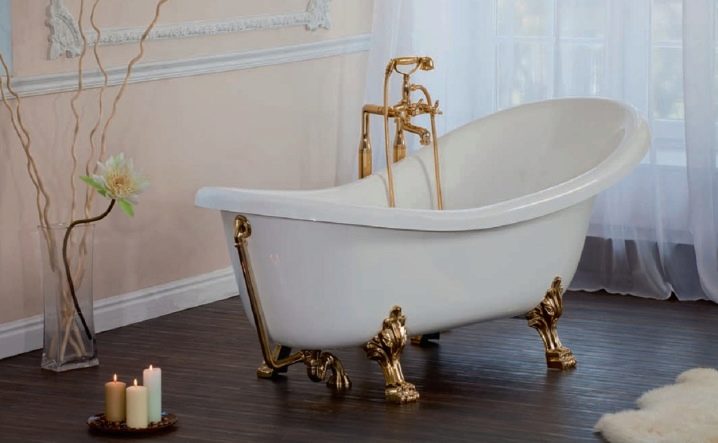
After all the steps taken, you only need to make sure that the structure is assembled correctly. To do this, cover the drain with a stopper, then open cold water and fill the bathtub with it.
Inspect the connections and drain carefully. If there are no leaks anywhere, then the plumbing can be safely used. The easiest way to notice a leak is to spread paper on the floor, on which dripping drops will immediately appear.
If you do find leaks in the structure, you can try to slightly tighten the nuts. When connecting different elements to each other, follow one simple rule: if a certain part is tightened and the thread "does not go" at the same time, it means that a leak may appear in this place.

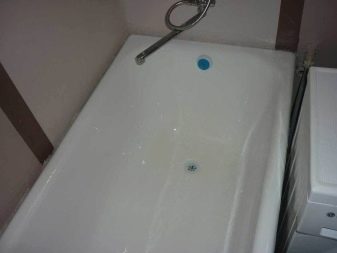
One of the most common causes of leaks is skewing, which occurs when rigid wiring is incorrectly fitted. Sometimes the correct installation is impeded by foam, which is often used for additional insulation of the bath.
Doesn't work well: what to do?
Over time, many users are faced with poor-quality operation of the siphon and the entire drainage system as a whole. The reasons for such problems may lie in the illiterate installation of all the components of the structure or in the blockage of pipes.
Mechanical blockages
Mechanical clogging of pipes can be caused by the ingress of sand and pebbles from shoes, animal hair, human hair and many other similar trifles into their inner part. All these components will certainly lead to a serious blockage of both pipes and the siphon itself. Because of this, the water from the bath is usually very poor and drains slowly.
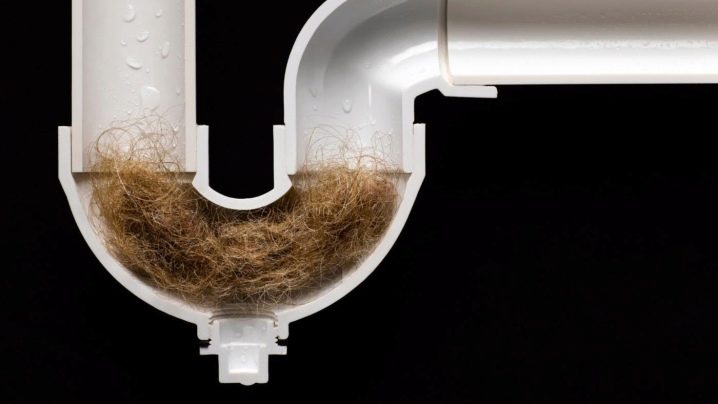
This problem can only be solved by thoroughly cleaning the pipes. However, in order not to encounter such events, it is worth installing a special fine mesh on the drain hole, which will prevent foreign particles from entering the pipes and siphon.
Operational
Such blockages, as a rule, lead to elementary misuse of the bath.In this case, clogging of pipes and a siphon can occur due to dirt and particles, which should remain on the protective mesh, but, unfortunately, not everyone uses it. In addition, a combination of fat and cold water often leads to operational blockages.

Technogenic
Water can also run badly due to an inexperienced craftsman who made many mistakes while renovating a bathroom in your home. Or maybe the fact is that the installation or replacement of plumbing in the room was not done according to technology. For example, you could have chosen the wrong level of installation of objects or made the wrong drain slope, which it should be.
To get rid of the listed problems, you need to either dismantle the plumbing (if it is installed incorrectly), or remove the blockages that have accumulated in the pipes.
- Thoroughly clean the siphon and drain - these are the main and vulnerable places where debris collects first. To do this, remove the siphon, and then unscrew the protective mesh. Note that this should be done with both the bathtub and the indoor sink.
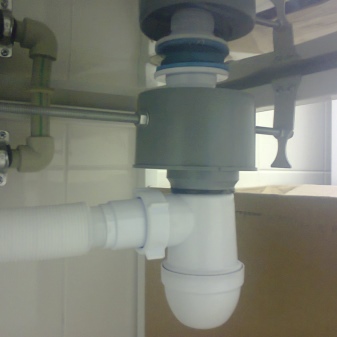

- Now shake out all of the removed parts into the toilet.
- Then thoroughly rinse the siphon, completely free of contamination, and with it all pipes, bowls, gaskets and protective mesh.
- Clean all parts with a brush with a good quality degreasing cleaner.
- Do the same with the mesh located on the sewer openings - these are the central areas of the accumulation of blockages.
- Clean out the corrugations that lead directly to the drain.

You can also clean pipes and corrugations mechanically. While the external elements of the drains are drying, mechanical cleaning devices should be used to clean the system. For this, a cable with a handle is most often used. It should be screwed into the depth of the sewer, trying to lower it as low as possible. After that, you need to get the cable and repeat the work done. It is advisable to do this several times to ensure the ideal frequency of the pipes.

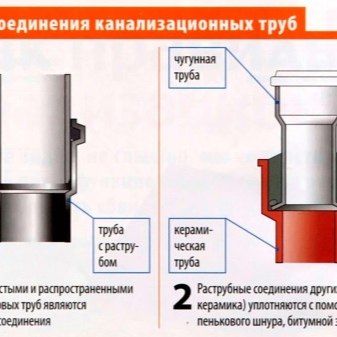
Next, you should proceed to chemical cleaning of the sewage system. To do this, it is necessary to fill the sewer with chemical compounds that are designed directly to break down fats and soften plaque. There are quite a few such tools. Some of the most popular are products such as "Mole", "Ton", "Tiret" and others. It is recommended to leave these funds for 15-20 minutes. Some people wait a little longer than 40-50 minutes. After the required amount of time, you should turn on the water in the bath for 10-15 minutes to remove all aggressive chemicals.
Manufacturers
Experts strongly recommend buying only high-quality siphons made by well-known companies with a good reputation. There are a lot of them on the modern market. Consider a few of the most popular and proven companies.
- Viega. This is a well-known brand from Germany that produces relatively inexpensive but high quality siphons made of brass, polypropylene, stainless steel and plastic.
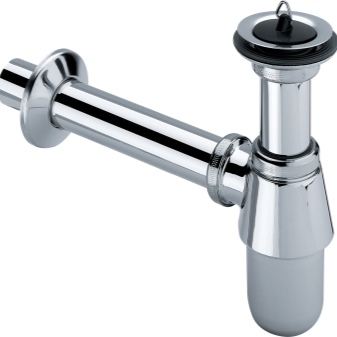
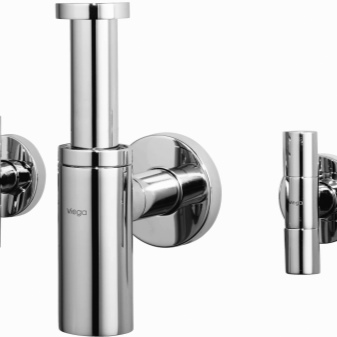
- Grohe. A large and popular brand offers a variety of high quality accessories for customers to choose from, designed for baths, sinks and toilets. The most popular additional elements of the company are neat chrome-plated siphons.
- Geberit. This is a well-known Swiss brand that produces plastic siphons in different price segments. A consumer with any budget will be able to choose the best option.
- Alcaplast. The Czech company offers modern consumers high-quality siphons with a 50 mm water seal, a drain-overflow system, and a convenient flexible hose.
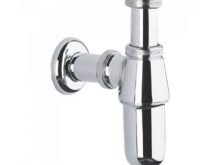
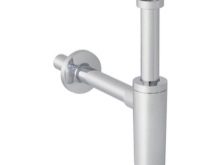
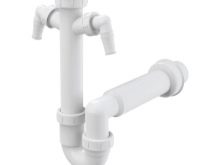
Tips & Tricks
If you decide to put a metal siphon, then it is better to buy options from copper or brass. Such specimens are not susceptible to corrosion. Moreover, they are not oxidized.Keep in mind that the more constituent parts are present in the siphon you purchased, the more it will be prone to breakdowns, like any other complicated system.
If you buy a cast iron siphon, then it should be borne in mind that it is not suitable for all bathroom models. Also, do not forget that such parts have a rather low level of corrosion resistance. If you are looking for more mobile siphons, then you should look for flexible tube models. They can be given any position that suits you.
If you notice serious damage to the parts of the siphon, then only replacing them or buying a new device will help you in solving this problem. Otherwise, leaks cannot be avoided.

Do not look for too cheap siphon models in stores. Most often, such options are of dubious quality and quickly fail. Select models (especially automatic) only from well-known manufacturers of sanitary fittings.
Take care of your bathroom pipes. Install protective screens over the drain holes. Otherwise, they may become clogged soon. Because of this, the water will not drain well and an unpleasant odor may appear. If you want to buy the most unpretentious siphon that does not need to be frequently cleaned of dirt, then you should look for a practical brass model.
Expensive automatic systems need to be treated with care. In this case, you only need to make one single movement to lift the plug. Do not hit the button harshly, make sure the system is working properly. In case of deficiencies, it is necessary to identify what the design problems are and be sure to solve them.

To extend the service life of the sealing cuffs and gaskets, it is necessary to coat them with a special silicone mixture in advance.
When cleaning pipes chemically, rubber gloves must be worn. It will also be useful to put on a respirator, since the chemicals you will have to work with are very aggressive and caustic. Try to avoid getting it on exposed skin.
When choosing a drainage system, always pay attention to absolutely all external elements that frame the holes in the bathtub. In a quality product, as a rule, these components are made of stainless steel.
If you decide to install a siphon with your own hands, then you should know that the installation of simple classical units is considered the easiest. If you are afraid to get involved with such work, then you should call an experienced master.
For the types and characteristics of bath siphons, see the following video.













The comment was sent successfully.